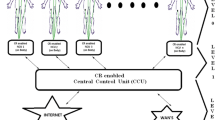Abstract
The demand for Wireless Sensor Network (WSN) in healthcare applications insists several factors, such as optimum utilization of resources, energy efficiency and channel sharing. However, bulk packet forwarding in WSN results data quality deterioration that might affect on-time diagnosis. Multi-channel usage technique, for an instance Cognitive Wireless Sensor Network (CWSN) ensures better channel utilization and communication quality. The study proposes a Channel Quality based Payload Allocation (CQ-PA) technique in CWSN. The physiological data of the user are fragmented into individual payloads with respect to parameters such as, accelerometer, pulse rate and spO2 and body temperature. The CQ-PA algorithm determines Channel Quality (CQ) metrics for all three available channels and eventually allocate appropriate payload in each channel. The proposed algorithm reduces computation complexity and also improves channel-overhearing. In this study, the participated nodes in CWSN, such as sensor nodes (Sn), relay node (R1) and a destination node (D) are indigenously developed by using CC2530 microcontroller that consists of an inbuilt transceiver at 2.4 GHz. CQ is used to determine current state for each channel and the obtained results are observed better performance than traditional WSN.




Similar content being viewed by others
References
Li, M., Wang, A., & Pan, J. S. (2016). Cognitive wireless networks using the CSS technology (Vol. 384). Berlin: Springer.
Phunchongharn, P., Hossain, E., Niyato, D., & Camorlinga, S. (2010). A cognitive radio system for e-health applications in a hospital environment. IEEE Wireless Communications, 17(1), 20–28.
Al Mamoon, I., Muzahidul Islam, A.K.M., Baharun, S., Wakabayashi, T., & Komaki, S.(2014) A priority aware cognitive radio based hospital system architecture, priority management and communication protocols. In 8th international symposium on medical information and communication technology (ISMICT) (pp. 1–5).
Ouattara, D., Quach, M.T., Krief, F., Chalouf, M.A., & Khalife, H. (2013) Mitigating the hospital area communication’s interference using Cognitive Radio Networks. In IEEE 15th international conference on e-health networking, applications & services (pp. 324–328).
Yin, Z., Wang, Y., & Wu, C. (2018). Reinforcement learning spectrum management paradigm in cognitive radio using novel state and action sets. Procedia Computer Science, 129, 433–437.
Wu, C., Wang, Y., & Yin, Z. (2018). Energy-efficiency opportunistic spectrum allocation in cognitive wireless sensor network. EURASIP Journal on Wireless Communications and Networking, 2018(1), 13.
Shafiee, M., & Vakili, V. T. (2018). Comparative evaluation approach for spectrum sensing in cognitive wireless sensor networks (C-WSNs). Canadian Journal of Electrical and Computer Engineering, 41(2), 77–86.
Ge, Y., Wang, S., & Ma, J. (2018). Optimization on TEEN routing protocol in cognitive wireless sensor network. EURASIP Journal on Wireless Communications and Networking, 2018(1), 27.
Karthikeyan, C. S., & Suganthi, M. (2017). Optimized spectrum sensing algorithm for cognitive radio. Wireless Personal Communications, 94(4), 2533–2547.
Alhumud, H., Zohdy, M., Debnath, D., & Olawoyin, R. (2019). Cooperative spectrum sensing for cognitive radio-wireless sensors network based on OR rule decision to enhance energy consumption in greenhouses. Wireless Sensor Network, 11, 1–11.
Verma, G., & Sahu, O. P. (2017). Removal of sensing-throughput tradeoff barrier in cognitive radio networks. Wireless Personal Communications, 94(3), 1477–1490.
Noda, C., Prabh, S., Alves, M., Boano, C. A., & Voigt, T. (2011). Quantifying the channel quality for interference-aware wireless sensor networks. ACM SIGBED Review, 8(4), 43–44.
Hermassi, H., Belazi, A., & Rhouma, R. (2014). Security analysis of an image encryption algorithm based on a DNA addition combining with chaotic maps. Multimedia Tools and Applications, 72(3), 2211–2224.
Acknowledgements
The authors gratefully acknowledge the financial support from Science for Equity Empowerment and Development Division under Department of Science and Technology, New Delhi, India by sanctioning a project—File No.: SSD/TISN/047/2011-TIE (G) to Velammal Engineering College, Chennai.
Author information
Authors and Affiliations
Corresponding author
Additional information
Publisher's Note
Springer Nature remains neutral with regard to jurisdictional claims in published maps and institutional affiliations.
Rights and permissions
About this article
Cite this article
Prakash, R., Balaji Ganesh, A. Cognitive Wireless Sensor Network for Elderly Home Healthcare. Wireless Pers Commun 107, 1815–1822 (2019). https://doi.org/10.1007/s11277-019-06358-2
Published:
Issue Date:
DOI: https://doi.org/10.1007/s11277-019-06358-2




